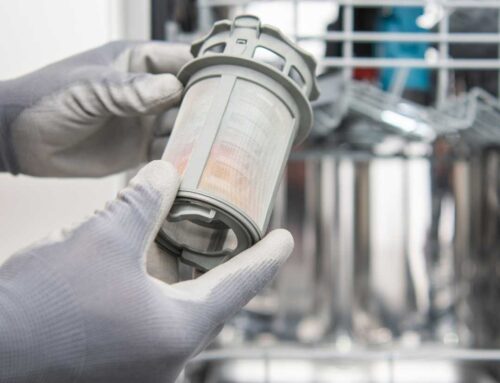With the weather turning colder, many people are now shifting their focus to the inside of their houses and doing projects there. One popular and easy improvement projects is painting your walls. However, while this is one of the easier home improvement projects you can do, if you don’t take the proper steps before, during, and after, it may not turn out. So how do you get the best results while painting? Here are a few tips and tricks to help you paint like a pro.
Prep Your Walls First
You may be anxious to slap the new paint on your walls, but if you don’t prepare the walls properly, you may not get the finish you want. If you are painting a wall that currently has wallpaper on it, remove the wallpaper before painting and be sure to wash off all adhesive before painting. If you are repainting a wall, check for stains, cracks, or holes in the wall, and repair those first. Primer can help with stains and wall surfaces that are generally in bad shape. For cracks, holes, and areas where the paint has peeled away, use spackle or, if the area is larger, a repair kit. Lightly sand the repaired area once spackle has dried to ensure there are no ridges. Once you have done all your repairs, it is a good idea to wash your wall with a mild detergent to remove any dirt before painting. Finally, our paint partner, Sherwin-Williams, suggests priming walls to help you get the true color and sheen you’re looking for from your paint. Plus, it provides a layer specially formulated to protect your topcoat.
Protect Areas You’re Not Painting
When your wall is fully prepped and ready for paint, the next step is ensuring the paint only ends up on the wall and not on furniture, baseboards, flooring, and other surfaces. Start by moving any furniture out of the way. Ideally, you should remove the furniture from the room, but if that is not possible, move it to the center of the room and cover it. For the best overall finish, remove switch and outlet plates, mirrors, light fixtures, hardware, and anything else affixed to the walls. If you cannot remove some of these items, wrap plastic around them or use tape to protect them from the paint. Next, use painters tape to protect baseboards, moldings, windows, and other areas you want to protect from paint. Finally, put down a drop cloth or tarp to protect flooring.
Use the Right Tools
In addition to the paint, you will need several other tools to do the job. For applying the paint, you will need brushes, a paint roller, and an extension pole for the roller. For brushes, use nylon, polyester, or a nylon/polyester blend for latex paint. For oil-based paints or an oil-based finish, use a natural brush or a nylon/polyester blend brush. Angled bristles make it easier to paint trim and achieve a straight line for cutting in corners and edges. Straight bristles are best for larger, flat areas.
When it comes to rollers, the size of the nap depends on the surface you are painting. A thicker nap holds more paint, so it will spread more evenly on more porous surfaces. For smooth or slightly textured surfaces (most walls), use a thinner nap of 1/4-inch or 3/8-inch.
The final item you will need is a paint try, which will give you the best results because the ramp of the tray helps evenly distribute paint on the roller. If you are doing a larger area, you could substitute a roller screen on a five-gallon bucket.
When it comes to paint and selecting a sheen, that is dependent on what you are painting. Here are some general tips from Sherwin-Williams:
Gloss Finish
The most light-reflective of any paint sheen, gloss paint has an extremely hard and shiny finish. Its rich, smooth luster makes it easily washable, often just wiping clean. Use this type of finish if you want to highlight a particular element of your room.
Recommended for: Wood trim, cabinets and doors.
Semi-Gloss Finish
A moderately reflective sheen, semi-gloss paint is also very durable and great for areas that need to be cleaned frequently.
Recommended for: Kitchens, bathrooms, closet doors, trim and utility areas.
Satin Finish
A satin finish paint has just a slight shine so it offers clean-ability while at the same time hiding minor imperfections in your wall’s surface. Ideal for high-traffic areas most likely to attract nicks, scuff marks and stains.
Recommended for: Kids’ bedrooms, kitchens, family rooms, foyers and hallways.
Matte and Flat Finish
Matte and flat finish paints soak up light rather than reflecting it, so they are your best choices for hiding surface imperfections in your walls. Typically, a matte finish cannot offer the same washability as glossier sheens, but Sherwin-Williams Emerald and Duration Home Interior paints come in a specially-engineered matte finish that easily washes clean, similar to gloss and semi-gloss paint.
Recommended for: Adult bedrooms and other areas that won’t get roughed up by kids. Also good for uneven or textured walls.
Painting Techniques and Tips
While painting, keep the area well ventilated by opening a door or window. According to Sherwin-Williams, the best order in which to paint a room is ceiling, walls, trim. For the ceiling, use a brush to paint a 2-inch wide strip on the ceiling where it meets the wall (known as cutting in). Then using a roller with an extension pole, start in a corner and work across the short side to maintain a wet edge. Use a similar technique on walls, starting by painting a 2-inch wide strip along the ceiling, floor, and woodwork with a brush. Then use a roller to fill in the rest of the wall, getting as close to the edges as possible to create a uniform finish. For trim, use a brush and sweep side to side with your strokes. First, apply paint in small section and work your way down the trim, then, without adding any paint to the brush, make one long stroke across the trim to create the appearance of long, smooth strokes.
Drying Time and Clean Up
When you are done painting, do not touch the wall for two hours to allow the paint to properly dry. While waiting for paint to dry, use the time to properly clean up and preserve your brushes, rollers, and paint for future usage. Wash brushes and rollers with warm water and a little bit of mild soap and rinse until all the paint is gone. Let them dry completely before storing them. For paint, hammer the lid back on and store in a dry place.




